

Ask the ‘crunchy’ big data questions that lead to breakthrough analytics. The Question to Ask Before Hiring a Data Scientist - Michael Li. By Michael Li | 10:00 AM August 6, 2014 When hiring data scientists, there’s nothing more frustrating than making the wrong hire.
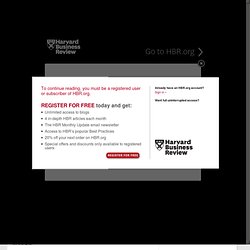
Data scientists are in notoriously high demand, hard to attract, and command large salaries — compounding the cost of a mistake. At The Data Incubator, we’ve talked to dozens of employers looking to hire data scientists from our training program, from large corporates like Pfizer and JPMorgan Chase to smaller tech startups like Foursquare and Upstart. Employers that didn’t have good hiring experiences in the past often failed to ask a key question: Is your data scientist producing analytics for machines or humans?
This distinction is important across organizations, industries, and job titles (our fellows are being placed at jobs with titles that range from Quant to Data Scientist to Analyst to Statistician). While this isn’t the only distinction among data scientists, it’s one of the biggest when it comes to hiring. It's Sink or Swim in the IoT's Ocean of Bigger Data. The network of connected devices commonly called the Internet of Things is poised to drive data growth to stratospheric levels.
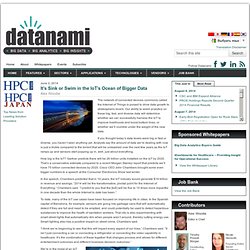
Our ability to wield analytics on these big, fast, and diverse data will determine whether we can successfully harness the IoT to improve livelihoods and boost bottom lines, or whether we’ll crumble under the weight of the new data. If you thought today’s data levels were big or fast or diverse, you haven’t seen anything yet.
Analysts say the amount of data we’re dealing with now is just a trickle compared to the torrent that will be unleashed over the next few years as the IoT ramps up and sensors start popping up in, well, just about everything. How big is the IoT? Gartner predicts there will be 26 billion units installed on the IoT by 2020. In the speech, Chambers predicted that in 10 years, the IoT industry would generate $19 trillion in revenue and savings. “2014 will be the transformative, pivotal point for the Internet of Everything,” Chambers said. DataHero: Unmask the Answers in Your Data.
Business Intelligence - Visualization, Reporting, Dashboards. Magic Quadrant for Business Intelligence and Analytics Platforms. Analyst(s): Rita L.
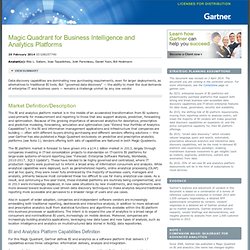
Sallam, Joao Tapadinhas, Josh Parenteau, Daniel Yuen, Bill Hostmann The BI and analytics platform market is in the middle of an accelerated transformation from BI systems used primarily for measurement and reporting to those that also support analysis, prediction, forecasting and optimization. Because of the growing importance of advanced analytics for descriptive, prescriptive and predictive modeling, forecasting, simulation and optimization (see "Extend Your Portfolio of Analytics Capabilities") in the BI and information management applications and infrastructure that companies are building — often with different buyers driving purchasing and different vendors offering solutions — this year Gartner has also published a Magic Quadrant exclusively on predictive and prescriptive analytics platforms (see Note 1).
Vendors offering both sets of capabilities are featured in both Magic Quadrants. Manifest Insights A Single Pane of Glass for your Data. One of the biggest challenges for companies today is the inability to see what is really happening at any given moment.
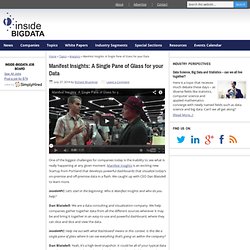
Manifest Insights is an exciting new Startup from Portland that develops powerful dashboards that visualize today’s on-premise and off-premise data in a flash. We caught up with CEO Dan Blaisdell to learn more. insideHPC: Let’s start in the beginning. Who is Manifest Insights and who do you help? Dan Blaisdell: We are a data consulting and visualization company. InsideHPC: Help me out with what ‘dashboard’ means in this context. Dan Blaisdell: Yeah, it’s a high level snapshot. InsideHPC: We’re here at OSCON with a lot of small companies like yours. Dan Blaisdell: I would say our key strength is how adaptable our solution is. We are going to be able to take the data from all different sources. InsideHPC: That is fascinating. Dan Blaisdell: Yeah, absolutely. Get SAP Lumira Free and start visualizing your data today! A Thumbnail History of Ensemble Methods. By Mike Bowles Ensemble methods are the backbone of machine learning techniques.
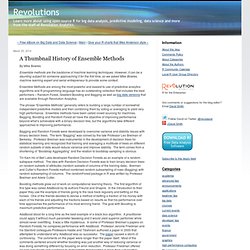
However, it can be a daunting subject for someone approaching it for the first time, so we asked Mike Bowles, machine learning expert and serial entrepreneur to provide some context. Ensemble Methods are among the most powerful and easiest to use of predictive analytics algorithms and R programming language has an outstanding collection that includes the best performers – Random Forest, Gradient Boosting and Bagging as well as big data versions that are available through Revolution Analytics. The phrase “Ensemble Methods” generally refers to building a large number of somewhat independent predictive models and then combining them by voting or averaging to yield very high performance. Ensemble methods have been called crowd sourcing for machines. Bagging and Random Forests were developed to overcome variance and stability issues with binary decision trees.
References Freund, Yoav and Schapire , Robert E.